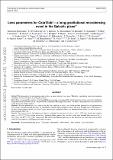Lens parameters for Gaia18cbf : a long gravitational microlensing event in the Galactic plane
Abstract
Context: The timescale of a microlensing event scales as a square root of a lens mass. Therefore, long-lasting events are important candidates for massive lenses, including black holes. Aims: Here, we present the analysis of the Gaia18cbf microlensing event reported by the Gaia Science Alerts system. It exhibited a long timescale and features that are common for the annual microlensing parallax effect. We deduce the parameters of the lens based on the derived best fitting model. Methods: We used photometric data collected by the Gaia satellite as well as the follow-up data gathered by the ground-based observatories. We investigated the range of microlensing models and used them to derive the most probable mass and distance to the lens using a Galactic model as a prior. Using known mass-brightness relation we determined how likely it is that the lens is a main-sequence (MS) star. Results: This event is one of the longest ever detected, with the Einstein timescale of tE=491.41+128.31-84.94 days for the best solution and tE=453.74+178.69-105.74 days for the second-best. Assuming Galaxy priors, this translates to the most probable lens mass of ML = 2.65+5.09-1.48 M⊙ and ML = 1.71+3.78-1.06 M⊙, respectively. The limits on the blended light suggest that this event was most likely not caused by a MS star, but rather by a dark remnant of stellar evolution.
Citation
Kruszyńska , K , Wyrzykowski , Ł , Rybicki , K A , Maskoliūnas , M , Bachelet , E , Rattenbury , N , Mróz , P , Zieliński , P , Howil , K , Kaczmarek , Z , Hodgkin , S T , Ihanec , N , Gezer , I , Gromadzki , M , Mikołajczyk , P , Stankevičiūtė , A , Čepas , V , Pakštienė , E , Šiškauskaitė , K , Zdanavičius , J , Bozza , V , Dominik , M , Figuera Jaimes , R , Fukui , A , Hundertmark , M , Narita , N , Street , R , Tsapras , Y , Bronikowski , M , Jabłońska , M , Jabłonowska , A & Ziółkowska , O 2022 , ' Lens parameters for Gaia18cbf : a long gravitational microlensing event in the Galactic plane ' , Astronomy & Astrophysics , vol. 662 , A59 . https://doi.org/10.1051/0004-6361/202142602
Publication
Astronomy & Astrophysics
Status
Peer reviewed
ISSN
0004-6361Type
Journal article
Description
Funding: This work was supported from the Polish NCN grants: Harmonia No. 2018/30/M/ST9/00311, Daina No. 2017/27/L/ST9/03221, MNiSW grant DIR/WK/2018/12 and NCBiR grant within POWER program nr POWR.03.02.00-00-l001/16-00. We acknowledge Research Council of Lithuania grant No S-LL-19-2 and European Commission’s H2020 OPTICON grant No. 730890 as well as OPTICON RadioNet Pilot grant No. 101004719. YT acknowledges the support of DFG priority program SPP 1992 “Exploring the Diversity of Extrasolar Planets” (TS 356/3-1). This work is partly supported by JSPS KAKENHI Grant Number JP18H05439, and the Astrobiology Center of National Institutes of Natural Sciences (NINS) (Grant Number AB031010).Collections
Items in the St Andrews Research Repository are protected by copyright, with all rights reserved, unless otherwise indicated.

